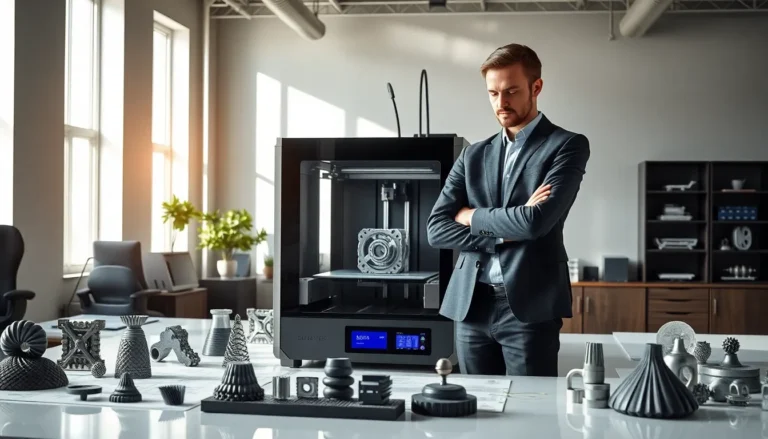Table of Contents
ToggleIn the world of 3D printing, your trusty machine might feel like a loyal dog that’s just a bit too old to fetch the ball. But fear not! With the right upgrades, it can become the sleek, fetching machine you always dreamed of. Whether you’re a hobbyist or a pro, enhancing your 3D printer can turn your mediocre prints into masterpieces that make Michelangelo weep with envy.
From swappable nozzles to heated beds, the right upgrades can unleash a torrent of creativity and efficiency. Imagine printing with precision that rivals a Swiss watchmaker—without the need for a degree in engineering. Dive into the world of 3D printer upgrades and discover how a few tweaks can elevate your printing game to legendary status. After all, who wouldn’t want to be the proud owner of a 3D printer that not only works harder but also smarter?
Overview of 3D Printer Upgrades
3D printer upgrades enhance performance and output quality significantly. Swappable nozzles offer flexibility in print resolution and material compatibility. Users can easily switch nozzles to achieve finer details or faster prints, depending on project requirements.
Heated beds improve adhesion during printing, reducing warping chances in materials like ABS and PETG. Enhanced bed surfaces, such as PEI or glass, provide consistent results across various filaments. Upgrading the bed surface can minimize print failures and enhance overall quality.
Extruder improvements lead to better filament feeding and flow. Direct drive and Bowden-style extruders possess different advantages. Direct drive systems allow easier printing with flexible filaments, while Bowden setups reduce the overall weight on moving parts, increasing print speed.
Adding auto bed leveling systems ensures proper first layer placement, critical for successful prints. Many devices support various leveling solutions, including capacitive, inductive, or mechanical probes. Proper calibration saves time and material, minimizing the possibility of failed prints.
Fans and cooling solutions directly impact print quality by preventing overheating and ensuring accurate layer adhesion. Upgrading fan systems results in efficient cooling, particularly for intricate designs and overhangs, allowing for smoother finishes and finer features.
Lastly, firmware updates provide vital enhancements, including improved motion algorithms and support for new features. Keeping firmware current offers better compatibility with new materials and techniques, ultimately enhancing the overall printing experience.
Popular Types of 3D Printer Upgrades

Numerous upgrades enhance 3D printer performance. Key modifications focus on hardware and software.
Hardware Upgrades
Upgrading hardware leads to significant improvements. Swappable nozzles provide flexibility for various print resolutions. Heated beds enhance adhesion and minimize warping in materials like ABS. Improved ventilation from upgraded cooling solutions maintains print quality. Enhanced bed surfaces, such as PEI and glass, reduce print failures. Upgraded extruders ensure better filament feeding, allowing for smoother operation. Auto bed leveling systems guarantee correct first layer placement, a crucial factor in successful prints. These hardware enhancements can transform an older printer into a high-performance machine.
Software Upgrades
Software upgrades deliver essential improvements to the printing experience. Updated firmware boosts compatibility with new materials and techniques. Slicing software enhancements optimize print settings, yielding better detail and efficiency. Users benefit from features like customizable support structures, which help achieve complex designs. Advanced settings in slicers improve layer adhesion and surface finish. Regular software updates often fix bugs and introduce new capabilities. Overall, these software advancements contribute significantly to print quality and operational ease.
Benefits of Upgrading Your 3D Printer
Upgrading a 3D printer significantly enhances the user’s experience and outcomes. Ensuring improvements in various aspects of printing leads to impressive results.
Improved Print Quality
Quality output becomes a reality with upgraded components. Swappable nozzles allow for adjustments in nozzle diameter, catering to different resolutions and materials. Heated beds play a crucial role in preventing warping, especially with materials like ABS and PETG. Using enhanced bed surfaces, such as PEI or glass, minimizes print failures and enhances adhesion. Proper cooling systems maintain optimal temperatures, preventing overheating and ensuring consistent layer adhesion. Investing in these upgrades transforms print quality from acceptable to exceptional.
Enhanced Printing Speed
Increased speed is another major advantage of printer upgrades. High-performance extruders optimize filament feeding, reducing delays during the printing process. Auto bed leveling systems establish a consistent first layer, so less time is wasted on recalibrating. Firmware updates often improve slicing algorithm efficiency, leading to quicker processing times. Users experience shorter build times while maintaining quality outputs. Enhancements contribute to overall productivity, allowing more time for experimentation and creativity in projects.
Considerations Before Upgrading
Prior to implementing upgrades, several factors warrant careful consideration. Users should assess compatibility, budget, and expected outcomes to ensure modifications align with their 3D printing goals.
Compatibility Issues
Before making any upgrades, check existing components for compatibility with new parts. Different 3D printers may have unique specifications. Modifications such as extruders, nozzles, or control boards can vary in fit and functionality. It’s crucial to verify whether new hardware integrates seamlessly with current systems. Consulting the manufacturer’s specifications or user manuals often provides clarity. Researching community feedback on specific upgrades helps gauge compatibility and performance expectations.
Budget Constraints
Budget plays a significant role in any upgrade decision. Determine a realistic budget that aligns with the desired enhancements. Some upgrades may offer substantial performance improvements, while others may provide minimal returns. It’s wise to prioritize essential components that deliver the most value for better prints. Setting aside funds for both hardware and software upgrades ensures a more comprehensive improvement to the 3D printing experience. Considering potential long-term benefits helps justify the initial investment.
Upgrading a 3D printer can unlock its full potential and elevate the quality of prints. With the right enhancements users can achieve remarkable results that meet both personal and professional standards. Investing in hardware and software upgrades not only improves performance but also boosts efficiency and creativity.
By carefully selecting compatible components and staying within budget users can transform their aging machines into powerful tools. Embracing these upgrades ensures that every print is a step toward mastering the art of 3D printing. It’s time to take the leap and explore the possibilities that await with a well-upgraded 3D printer.




